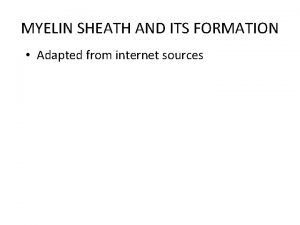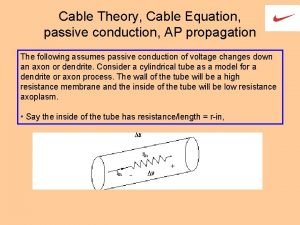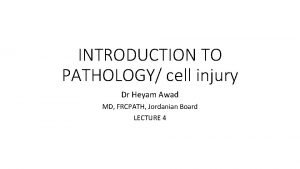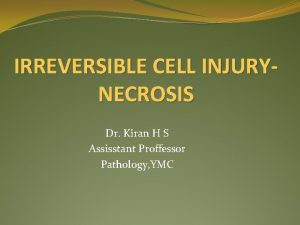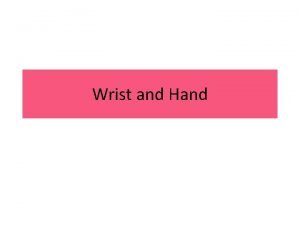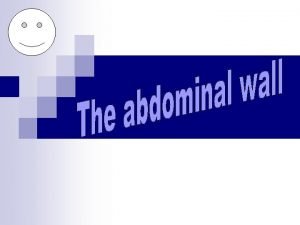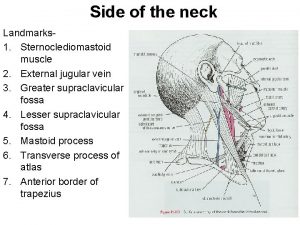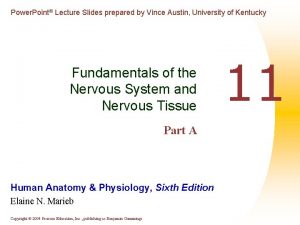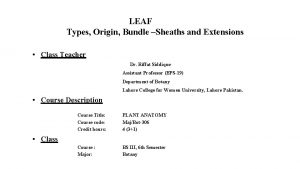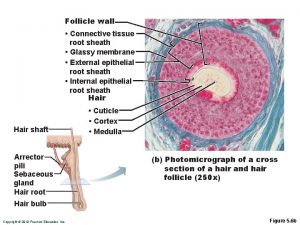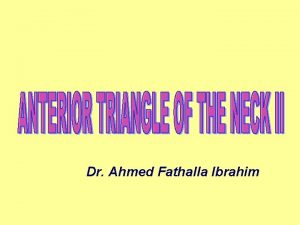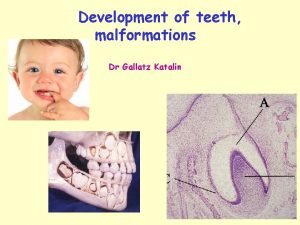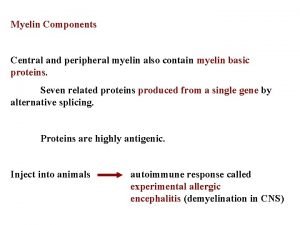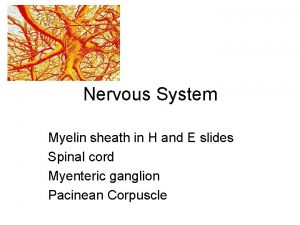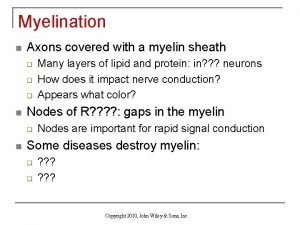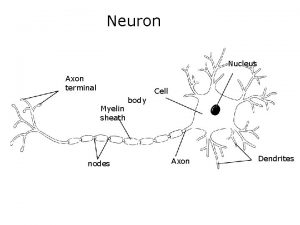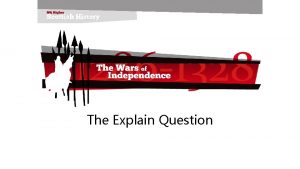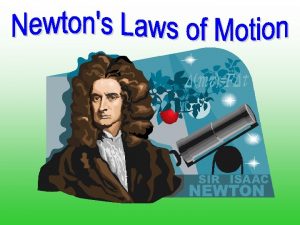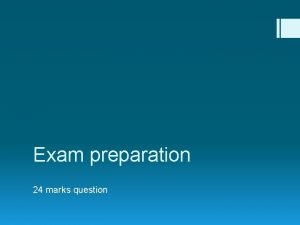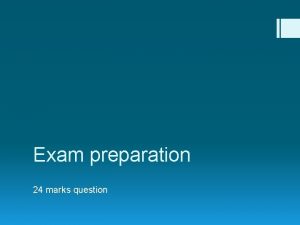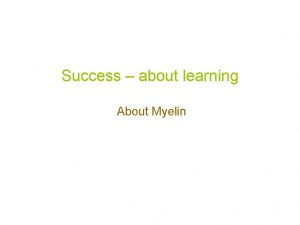Recap Question Explain how the myelin sheath causes

















- Slides: 17

Recap Question: Explain how the myelin sheath causes saltatory conduction. 5. 1. 3 Neuronal Communication • The myelin sheath is closely bound to the membrane of the neurone: this prevents movement of ions across the membrane. • Movement of ions across the membrane can only occur where there are gaps in the myelin sheath. • These gaps occur at the nodes of Ranvier. • The local currents are extended to carry the impulse between the nodes of Ranvier. Nerve Junctions

Starter Complete memory game - Synapse

Learning Objectives To understand how information is transmitted across a synapse Success Criteria Describe (with the aid of diagrams) the structure of a cholinergic synapse (Grade E - D) Explain the role of neurotransmitters in transferring action potentials (Grade C –B) Apply understanding of synapses to explain how drugs work (Grade B – A)

4 of 38 © Boardworks Ltd 2009

Cholinergic Synapses • A synapse is a junction between two or more neurones. This is an electron micrograph of synapses between nerve fibres and a neurone cell body. • Allows signalling (communication) between neurones • The small gap between the neurones is called the synaptic cleft. • Acetylcholine is a common transmitter. • Synapses that have acetylcholine transmitter are called cholinergic synapses. Cholinergic synapses are common in vertebrates, where they occur in the CNS and at neuromuscular junctions

The structure of the synapse 6 of 38 © Boardworks Ltd 2009

What happens at a synapse? 7 of 38 © Boardworks Ltd 2009

8 of 38 © Boardworks Ltd 2009

What happens at a cholinergic synapse? Stage 1 • An action potential arrives at presynaptic membrane. Voltage gated calcium channels in the presynaptic membrane open, calcium ions enter the presynaptic neurone along a concentration gradient. • Afterwards these are pumped out using ATP.

What happens at a cholinergic synapse? Stage 2 • Calcium ions cause synaptic vesicles to fuse with the presynaptic membrane, releasing acetylcholine into the synaptic cleft (exocytosis). • This also requires ATP as it is an active process.

What happens at a cholinergic synapse? Stage 3 • Acetylcholine diffuses cross the synaptic cleft and binds to specific neuroreceptor sites in the post synaptic membrane.

What happens at a cholinergic synapse? Stage 4 • Sodium channels open. Sodium ions diffuse rapidly along a concentration gradient into the postsynaptic membrane causing a generator potential or excitatory postsynaptic potential (EPSP). • If sufficient generator potentials combine then the potential across the membrane reaches a threshold potential • A new action potential is created

What happens at a cholinergic synapse? Stage 5 • The enzyme acetylcholinesterase hydrolyses acetylcholine into choline and ethanoic acid (acetyl). • The products diffuse back into the presynaptic neurone where acetycholine is resynthesised using ATP from the mitochondria. • The break down of acetylcholine prevents it from continuously generating a new action potential

Effects of drugs on synapses • Drugs which have molecules of similar shape to transmitter substances can affect protein receptors in postsynaptic membranes. • Agonists – mimic the effect of neurotransmitters 1) Stimulating the release of more neurotransmitter 2) Inhibiting the enzyme that breaks down the neurotransmitter Stimulates the nervous system by creating more APs in postsynaptic neurones. Nicotine, caffeine, amphetamines, ecstasy • Antagonists – block the effects of neurotransmitters 1) Inhibiting the release of neurotransmitter 2) Blocking the receptors on the Na/K ion channels on the postsynaptic membrane Reduce the occurrence of EPSPs Beta blockers 14 of 38 © Boardworks Ltd 2009

Task • Describe the type and effects of these drugs: • Carbachol – binds and activates cholinergic receptors – suggest the effect on saliva secretion. • Tubocurarine (rocuronium) is used as an anaesthetic. Suggest how it works. 15 of 38 © Boardworks Ltd 2009

Transmission across a synapse 16 of 38 © Boardworks Ltd 2009

Learning Objectives • To understand how information is transmitted across a synapse Success Criteria • Describe (with the aid of diagrams) the structure of a cholinergic synapse (Grade E - D) • Explain the role of neurotransmitters in transferring action potentials (Grade C –B) • Apply understanding of synapses to explain how drugs work (Grade B – A) 17 of 38 © Boardworks Ltd 2009
 Na+ equilibrium potential
Na+ equilibrium potential What does the myelin sheath look like
What does the myelin sheath look like Types of synapse
Types of synapse Myelin length constant
Myelin length constant Myelin figures in reversible cell injury
Myelin figures in reversible cell injury Necrosis
Necrosis Costa question levels
Costa question levels Proximate cause and ultimate cause
Proximate cause and ultimate cause Proximate behaviour in animals
Proximate behaviour in animals 1st and 2nd lumbricals
1st and 2nd lumbricals Radial sheath
Radial sheath Hernia meaning
Hernia meaning Contents of carotid sheath
Contents of carotid sheath Neurilemmal sheath
Neurilemmal sheath Bundle sheath extension function
Bundle sheath extension function Hair follicle anatomy
Hair follicle anatomy Carotid sheath contents
Carotid sheath contents Dental papilla gives rise to
Dental papilla gives rise to

